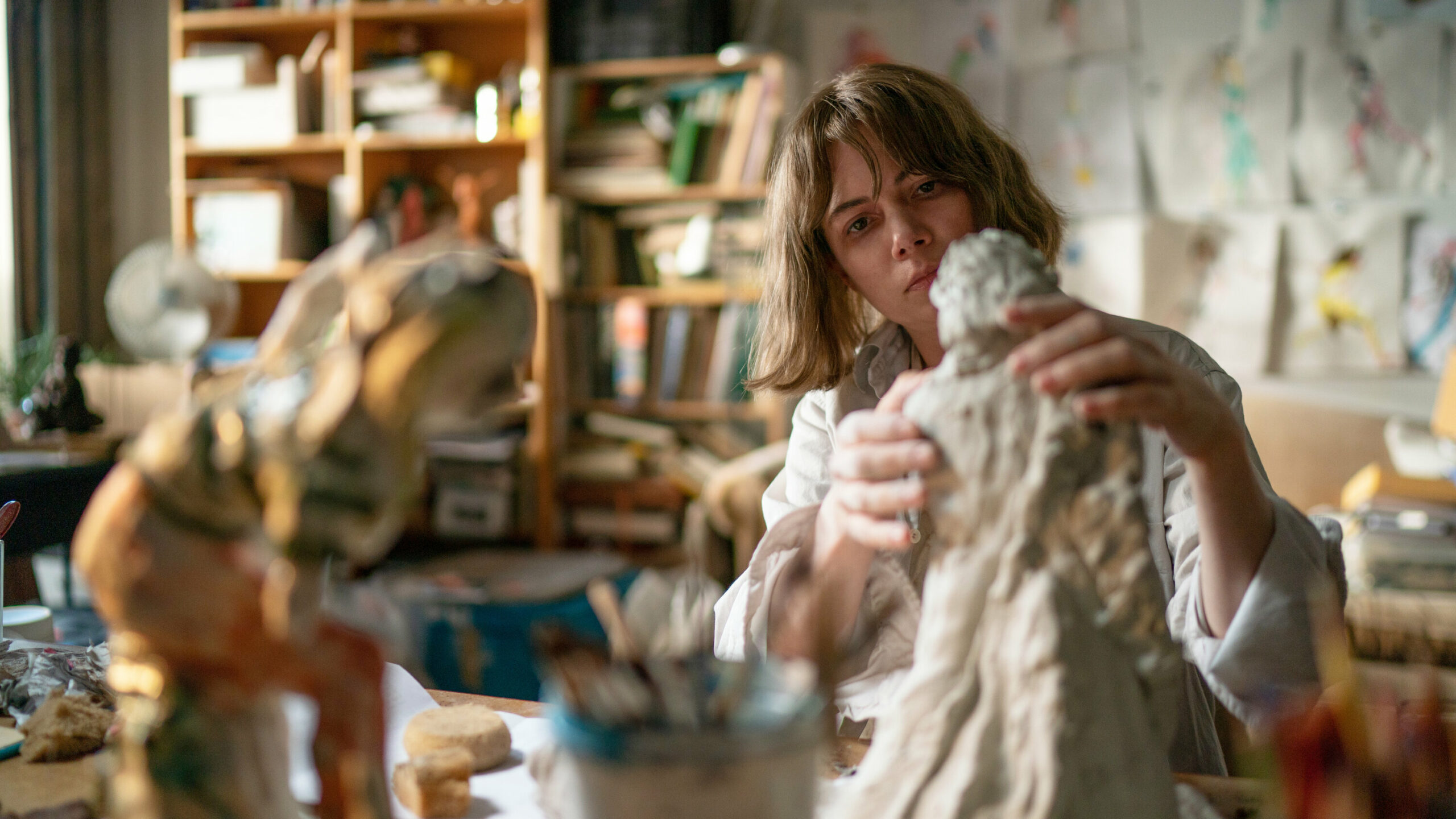
I think my work also has benefited from distractions. There are times when my writing has had to come second to my family or my neighbors or my horses or my sheep. These reminders of things more important than writing have kept my writing firmly placed in the workaday world, where it belongs. – Wendell Berry, in an interview for Garden & Gun magazine
I could let the above quote stand alone as my review of Kelly Reichardt’s latest film, Showing Up, which is about a sculptor named Lizzy (played with frumpy precision by Reichardt’s most frequent muse Michelle Williams) who handles the distractions that arise as she prepares for an upcoming gallery show. I’ll write more though because the film warrants it, and I don’t want you to feel you’ve wasted a click.
Lizzy is a sculptor. She is also a graphic designer, a tenant, a friend, a daughter, a sister, and a cat owner. For most of Showing Up, she plays nurse to an injured pigeon as well. We may like to imagine the life of an artist as lived in the clouds, responsible only to the winds of their artistic process, caught in the ebb and flow of inspiration. Showing Up disabuses us of that idea almost instantly. Art-making happens in the messiness of Lizzy’s life. She may wish for more space and time to do her work, but as we watch her, we suspect she relishes the distractions as well, though she would almost certainly never admit it.
Lizzy’s sculptures are essential to the film. They are the real-life work of sculptor Cynthia Lahti. The style is dynamic and rough, as if the figures are in motion. She glazes them with bright colors. You can see strong emotions captured in the clay. This contrasts with what we see of Lizzy herself. She is meek. She wears drab colors. She walks furtively even when she is alone.
So where does the liveliness and emotion in her sculptures come from? My guess is that it comes from the world around her. It comes from her relationships. It comes from the distractions which are essential to her life. Her art is her life.
That previously mentioned pigeon plays a big role in Showing Up. I hesitate to pin too definitive an interpretation on it. It works more like the symbols you find in Krzysztof Kieślowski’s films. They are rich with meaning that arise out of the circumstance of the story, and the particular meaning is, in large part, open to each individual audience member. They make you feel something more than they make you know something. The pigeon serves that purpose in Showing Up. I didn’t know I could be moved so deeply by a pigeon, but then again, film is art, and the pigeon is part of the “sculpture” Kelly Reichardt and her collaborators have made. It lifted me out of my head, out of the film even, and back out and up into the world.
I think my work also has benefited from distractions. There are times when my writing has had to come second to my family or my neighbors or my horses or my sheep. These reminders of things more important than writing have kept my writing firmly placed in the workaday world, where it belongs. – Wendell Berry, in an interview for Garden & Gun magazine
I could let the above quote stand alone as my review of Kelly Reichardt’s latest film, Showing Up, which is about a sculptor named Lizzy (played with frumpy precision by Reichardt’s most frequent muse Michelle Williams) who handles the distractions that arise as she prepares for an upcoming gallery show. I’ll write more though because the film warrants it, and I don’t want you to feel you’ve wasted a click.
Lizzy is a sculptor. She is also a graphic designer, a tenant, a friend, a daughter, a sister, and a cat owner. For most of Showing Up, she plays nurse to an injured pigeon as well. We may like to imagine the life of an artist as lived in the clouds, responsible only to the winds of their artistic process, caught in the ebb and flow of inspiration. Showing Up disabuses us of that idea almost instantly. Art-making happens in the messiness of Lizzy’s life. She may wish for more space and time to do her work, but as we watch her, we suspect she relishes the distractions as well, though she would almost certainly never admit it.
Lizzy’s sculptures are essential to the film. They are the real-life work of sculptor Cynthia Lahti. The style is dynamic and rough, as if the figures are in motion. She glazes them with bright colors. You can see strong emotions captured in the clay. This contrasts with what we see of Lizzy herself. She is meek. She wears drab colors. She walks furtively even when she is alone.
So where does the liveliness and emotion in her sculptures come from? My guess is that it comes from the world around her. It comes from her relationships. It comes from the distractions which are essential to her life. Her art is her life.
That previously mentioned pigeon plays a big role in Showing Up. I hesitate to pin too definitive an interpretation on it. It works more like the symbols you find in Krzysztof Kieślowski’s films. They are rich with meaning that arise out of the circumstance of the story, and the particular meaning is, in large part, open to each individual audience member. They make you feel something more than they make you know something. The pigeon serves that purpose in Showing Up. I didn’t know I could be moved so deeply by a pigeon, but then again, film is art, and the pigeon is part of the “sculpture” Kelly Reichardt and her collaborators have made. It lifted me out of my head, out of the film even, and back out and up into the world.

Elijah Davidson is Co-Director of Brehm Film and Senior Film Critic. Subscribe to Come & See, his weekly newsletter that guides you through the greatest films ever made, and find more of his work at elijahdavidson.com.
The young people in How to Blow Up a Pipeline have their faces “set like flint” to the task ahead of them as well. They aren’t going to turn over tables in the synagogue… well, actually they kind of are.